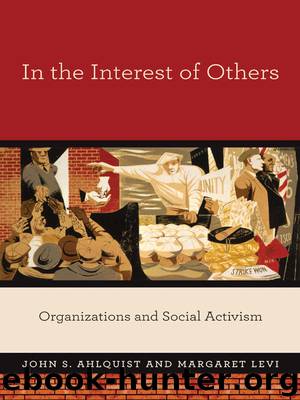In the Interest of Others by Levi Margaret; Ahlquist John S.;

Author:Levi, Margaret; Ahlquist, John S.;
Language: eng
Format: epub
Publisher: Princeton University Press
Published: 2013-07-17T16:00:00+00:00
Preference Provocation
Theorists have developed several ways of formalizing “endogenous preferences” (Bowles 1998; Bowles and Polanía-Reyes 2011). Here we simply extend the notation of the model developed in chapter 2 to incorporate the realistic possibility that members are not neutral with respect to the leader’s activist projects, nor are they indifferent to the activities of their fellows. These extensions do not alter the basic results from chapter 2 but they provide added nuance and flexibility.
Recall the strategic setting outlined earlier: We have a group of union members and a “leader.” In the notation developed in chapter 2, an individual’s payoffs, net of costly effort contributed to the group’s core project, is The parameter θ governs group productivity and is assumed stochastic. The leader knows (or expends effort, ξ, to learn and communicate) the value of θ. But the leader has an incentive to misrepresent the truth, telling the rank and file that times are good when in fact they are not. In a repeated game situation, the leader can develop a reputation for honestly communicating her knowledge; this behavior is supported by the threat that the rank and file will ignore the leader in all subsequent periods if the leader should mislead them.
We also showed that allowing the leader to earn rents expands the set of truth-telling equilibria. The members each contributed some costly resources, ri, to the leader’s compensation; member payoffs are Leaders received payoffs V1 − ξ + y1R, Where Leaders who are “extreme” in the sense of valuing these rents a great deal are cheaper to compensate from the members’ perspective. Further, credibly promising rents conditional on past behavior enables the members to select leaders who are relatively “cheap” to compensate while also providing incentives for leaders to pay the costs of building a reputation for good leadership and delivering on it. We argued that the ability to call on the union for political activism is one form of leadership rents—one that has particular implications for organizational governance.
We initially assumed all members were identical and the group was small enough that an individual’s marginal contribution was non-negligible. We relax both these assumptions. First we allow for heterogeneity in members’ preferences over their contributions to the leader’s rents. In other words, union members might also benefit from their contributions to the leader’s rents if they share (or come to share) the leader’s preferences and if the leader’s rents also generate spillovers or other group benefit.5 These additional benefits develop dynamically as part of organizational membership; they are “provoked.”
Specifically, leaders who ask the rank and file to contribute to political projects face the possibility that some of the rank and file might share her commitments and likewise derive benefits from the union’s expanded scope of action. These benefits could be psychic, in the sense of acting in accordance with one’s principles, or it could be the feeling of efficacy gained through group action, what Wood calls “the pleasure of agency” (Wood 2001, 2003).6 Or the union may succeed in affecting
Download
This site does not store any files on its server. We only index and link to content provided by other sites. Please contact the content providers to delete copyright contents if any and email us, we'll remove relevant links or contents immediately.
| Anthropology | Archaeology |
| Philosophy | Politics & Government |
| Social Sciences | Sociology |
| Women's Studies |
The Secret History by Donna Tartt(18122)
The Social Justice Warrior Handbook by Lisa De Pasquale(11948)
Thirteen Reasons Why by Jay Asher(8435)
This Is How You Lose Her by Junot Diaz(6424)
Weapons of Math Destruction by Cathy O'Neil(5815)
Zero to One by Peter Thiel(5479)
Beartown by Fredrik Backman(5337)
The Myth of the Strong Leader by Archie Brown(5226)
The Fire Next Time by James Baldwin(5011)
How Democracies Die by Steven Levitsky & Daniel Ziblatt(4948)
Promise Me, Dad by Joe Biden(4904)
Stone's Rules by Roger Stone(4845)
100 Deadly Skills by Clint Emerson(4682)
A Higher Loyalty: Truth, Lies, and Leadership by James Comey(4542)
Rise and Kill First by Ronen Bergman(4541)
Secrecy World by Jake Bernstein(4381)
The David Icke Guide to the Global Conspiracy (and how to end it) by David Icke(4374)
The Farm by Tom Rob Smith(4318)
The Doomsday Machine by Daniel Ellsberg(4238)
